John Burch is a friend of mine, and he’s a nano-technology guy. Despite his best efforts to explain it to me, I have to tell you that he might as well be speaking in ancient tongues. That said, I do understand this: nano means itsy-bitsy.
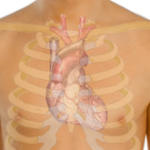 Imagine my surprise, therefore, to find an article in AVweb about current-day, practical application of nano-technology to a problem very close to my heart. And by that I mean, as in a dagger pointed at my heart.
Imagine my surprise, therefore, to find an article in AVweb about current-day, practical application of nano-technology to a problem very close to my heart. And by that I mean, as in a dagger pointed at my heart.![]()
In addition to combat during my forty-plus years as a professional aviator, two hazards could get my attention faster than any others: microbursts associated with thunderstorms, and structural icing. This blog post will address the latter. It requires a bit of technical explanation for non-flyers, so any pilots reading this can take a nap for a moment.
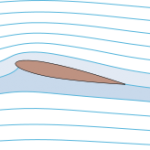
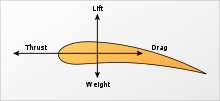 Airplanes can fly because their wings produce more lift than the airplane weighs. That process works best when air flows smoothly over the top and the bottom of the wing. For the purposes of this discussion, let’s assume an airplane is in a steady-state, un-accelerated, straight-and-level flight condition, cruising along with the pilot fat, dumb, and happy, not a care in the world. If we analyze the forces acting on the airplane, thrust equals drag, and lift equals weight. The latter two are our focus here. (And no, the diagram on the right doesn’t reflect our example condition, but an airplane accelerating and climbing.)
Airplanes can fly because their wings produce more lift than the airplane weighs. That process works best when air flows smoothly over the top and the bottom of the wing. For the purposes of this discussion, let’s assume an airplane is in a steady-state, un-accelerated, straight-and-level flight condition, cruising along with the pilot fat, dumb, and happy, not a care in the world. If we analyze the forces acting on the airplane, thrust equals drag, and lift equals weight. The latter two are our focus here. (And no, the diagram on the right doesn’t reflect our example condition, but an airplane accelerating and climbing.)
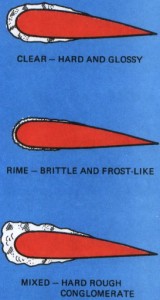 Now let’s instantly cover the wings and tail surfaces with a layer of ice. Thankfully it doesn’t usually happen that way, but this hypothetical scenario allows us to analyze the impact of the ice, and it’s a double whammy. That’s not a pilot term, although it’s apropos in this context.
Now let’s instantly cover the wings and tail surfaces with a layer of ice. Thankfully it doesn’t usually happen that way, but this hypothetical scenario allows us to analyze the impact of the ice, and it’s a double whammy. That’s not a pilot term, although it’s apropos in this context.
First, ice adds to the weight of the airplane. To maintain altitude, the pilot must increase lift. But the ice also disrupts the airflow over the wings and reduces lift. If the layer of ice continues to thicken, at some point the airplane cannot maintain altitude and must descend or stall.
Pilots are taught to avoid ice if possible, and if they can’t, how to deal with it. The problem is that dealing with it effectively requires special equipment. Without an anti-ice (don’t let it form) or de-ice (remove it after it forms) system installed, the only option is to leave icing conditions before the ability of the airplane to maintain a safe altitude is compromised.
Structural icing can form in a variety of atmospheric conditions, and it doesn’t necessarily require freezing temperatures at the time of formation. I flew into Billings, Montana, in a DC-9 one fall on an out-and-back from Houston, Texas. The weather in Billings wasn’t a factor, partly cloudy and cold, but not freezing. The hours spent in cruise at about 35,000 feet, however, had cold-soaked the airplane to well below freezing temperatures, and the “quick turnaround” for the return flight to Houston meant that the skin had not warmed up much, if at all.
 Atmospheric conditions on the ground didn’t meet the flight manual criteria for using our anti-icing systems for the takeoff, nor did they present justification for using them during the climb. Passing an altitude of about 6000 feet (3,000 feet above the ground), we flew through a single cloud that enveloped the aircraft for 20-30 seconds. As we popped out into clear air, I happened to notice that the windshield wiper, one of the first places we looked to verify that the airplane was beginning to ice up, had been completely coated. Strangely enough, a column of ice about two inches tall had formed on a nut holding the wiper blade to the windshield frame. Ice there isn’t critical, but it doesn’t only choose the nut as a target, either.
Atmospheric conditions on the ground didn’t meet the flight manual criteria for using our anti-icing systems for the takeoff, nor did they present justification for using them during the climb. Passing an altitude of about 6000 feet (3,000 feet above the ground), we flew through a single cloud that enveloped the aircraft for 20-30 seconds. As we popped out into clear air, I happened to notice that the windshield wiper, one of the first places we looked to verify that the airplane was beginning to ice up, had been completely coated. Strangely enough, a column of ice about two inches tall had formed on a nut holding the wiper blade to the windshield frame. Ice there isn’t critical, but it doesn’t only choose the nut as a target, either.
We turned on the anti-ice systems and took care of any that might have forned on the wings or tail surfaces, but I’ll always remember how surprisingly fast the ice glommed onto us.
Anti-ice systems use electrical heating elements or bleed air (hot) from the engines to keep critical surfaces free of ice. De-ice systems typically use rubber “boots” that are filled with engine bleed air, not to melt the ice, but to inflate the boot and destroy the structural integrity of the ice layer after it forms.
Nano-technology may offer a strikingly different alternative. AVweb (edited for presentation here):
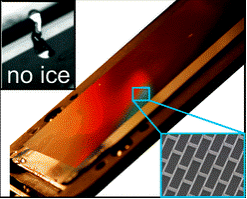 “The project began with a look at the legs of mosquitoes and water strider insects. The insects manage to keep dry thanks to an array of bristles that minimize surface area and repel water droplets. Researchers from Harvard University have developed and tested specific, patterned, nanostructured materials that reject supercooled water droplets before that water can freeze to a surface. When supercooled droplets hit smooth surfaces, the researchers found they spread out and freeze. That was not the case when the Harvard team applied the same tests to nanostructures created with patterns that reduced the surface area to which the water could adhere.
“The project began with a look at the legs of mosquitoes and water strider insects. The insects manage to keep dry thanks to an array of bristles that minimize surface area and repel water droplets. Researchers from Harvard University have developed and tested specific, patterned, nanostructured materials that reject supercooled water droplets before that water can freeze to a surface. When supercooled droplets hit smooth surfaces, the researchers found they spread out and freeze. That was not the case when the Harvard team applied the same tests to nanostructures created with patterns that reduced the surface area to which the water could adhere.
“Perhaps counter-intuitively, that involved adding texture to the surface on a microscopic level. In their most successful tests, a supercooled droplet would initially hit the surface and spread out. But instead of freezing, the droplets would then retract back into a sphere and simply bounce off.
 “The research tested materials and showed them to prevent ice formation down to -30C. Below that, ice did form, but did not adhere as well as it did to non-nanostructured surfaces and was considered easier to remove. The research is now moving from controlled tests to real-world settings. The group hopes to be able to develop coatings best described as ice-preventive materials specifically designed for particular applications.”
“The research tested materials and showed them to prevent ice formation down to -30C. Below that, ice did form, but did not adhere as well as it did to non-nanostructured surfaces and was considered easier to remove. The research is now moving from controlled tests to real-world settings. The group hopes to be able to develop coatings best described as ice-preventive materials specifically designed for particular applications.”
Now that, dear reader, is cool . . . the right kind of cool, dude.


